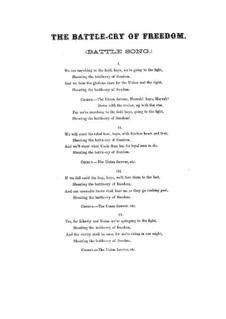
The bulk of the sheet music was transferred to the Library between 20. Last collection of graphic arts and social history, which was donated to the Huntington Library by Jay T. Provenance This collection forms part of the Jay T. Last Collection of Graphic Arts and Social History, Huntington Digital Library

United States-History-Civil War, 1861-1865-Songs and musicġ861-1865 Union: Battles, Camp Life & Misc. "Copcutt-Williams" Advertisement on page : "New Music: Published by Root & Cady." Black and white lithograph of balttlefield and home life scenes. Last Collection of Graphic Arts and Social Historyįor information on use of Digital Library materials, please see Library Rights and Permissions: ĭescription For voice and piano. (George Frederick), 1820-1895, composerĬollection Jay T. A few of the songs will probably be familiar to many readers.Title The battle cry of freedom / by Geo. George Frederick Root was a 19th century American poet, musician and. It does not include pieces that Root merely arranged. The Battle Cry of Freedom Tramp Tramp Tramp George Frederick Root Biography. The following list of his songs related to the Civil War, taken from the Library of Congress Civil War Sheet Music Collection, is quite long enough. One site, which from the small size of the little bubble on the scroll bar promised to have extensive biographical information, instead comprises mostly a list of his complete output. If Root had written nothing else, that one song would assure him a place in America’s musical history. Only those who were at the front, campoing, marching, battling for the flag, can fully realize how often we were cheered, revived, and inspired by the songs of him who sent forth the “Battle Cry of Freedom.” Root’s name alongside our great generals. The true and correct history of the war for the maintenance of the Union will place George F. In an 1889 testimonial banquet in Root’s honor, former Union soldier J. That figure doesn’t count the number of times it appeared in collections or arrangements for piano or guitar. “Battle Cry of Freedom” (1862), easily Root’s best-known song to this day, sold 350,000 copies in sheet music. The Battle Cry Of Freedom (Union Version) Lyrics Verse 1 Yes we'll rally round the flag, boys, we'll rally once again Shouting the battle cry of freedom We will rally from the hillside, we'll. It is easy to write correctly a simple song, but so to use the material of which such a song must be made that it will be received and live in the hearts of the people is quite another matter.

“Hazel Dell” (published in 1853 by William Hall & Son in New York) and “Rosalie, the Prairie Flower” (1855, by Russell & Richardson in Boston) were the best known.

Friedrich Wurzel” (the German for Root) to them instead of my own name. Foster’s wonderful melodies (as I now see them) began to appear, and the famous Christy’s Minstrels began to make them known, I “took a hand in” and wrote a few, but put “G. battle cry of freedom George Frederick Root, Battle Cry of Freedom, 1862. I saw that mine must be the “people’s song,” still, I am ashamed to say, I shared the feeling that was around me in regard to that grade of music. A page for describing Quotes: American Civil War. After spending some time and energy teaching and composing music based on European models, he had a change of heart. After touring Europe in 1850, he returned to Boston and worked with Lowell Mason, the leading “reformer” of American Hymnody. Webb and, in 1845, moved to New York to establish a career as church organist and music teacher. George Frederick Root was born in 1820 in Sheffield, Massachusetts to a musical family. Between the two of them, they composed all of the best-selling songs in the firm’s catalog and probably more big hits than any other Northern composer. The firm of Root & Cady employed two composers (the founder’s younger brother George Frederick Root and Henry Clay Work).

Chicago was the musical capital of the North when it came to production of great Civil War songs.


 0 kommentar(er)
0 kommentar(er)
